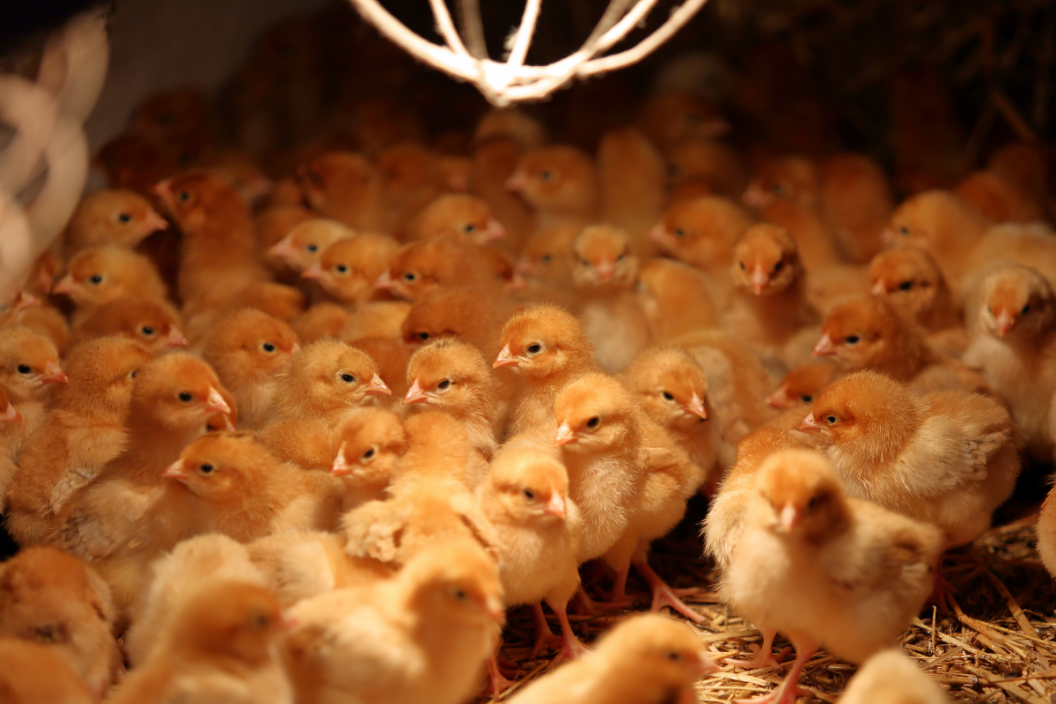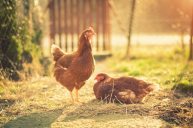Whether you are new to raising chickens or your new chicks will be hatching soon, we are here to help you with all you need to know about keeping your new babies warm and happy.
If you have baby chicks, we've put together a guide to keeping your chicks warm.
We cover how to set up a heat lamp as well as alternate heat sources, and we'll tell you not only how to set up the heat, but also how long your chicks need a heat lamp and at what temperature.
How Long Do Baby Chicks Need a Heat Lamp?
Baby chicks need supplemental heat (a heat lamp, a Brinsea Ecoglow, or a mama hen) to keep the brooder box warm for about four to six weeks depending on the outside temperatures.
Chicks start out needing a higher temperature, between 100 and 95 degrees, but as the weeks pass, lower that temperature each week by about five degrees until the little ones are feathered at six weeks, or until the brooder temperature is the same as the outside temperature. Hopefully, you aren't raising chicks in cold weather, but if you are, it's more likely that you'll need supplemental heat for at least six weeks.
Week By Week Temperatures
Week 1: 95-100 degrees Fahrenheit (in the first week, this is a heat lamp about 18 inches from bedding - always check the temp in setting up and adjust per thermometer and bulb wattage)
Week 2: 90-95 degrees F
Week 3: 85-90 degrees F (this is the week where chicks start to get really dusty and messy if the brooder is in the house)
Week 4: 80-85 degrees F
Week 5: 75-80 degrees F (when the ambient temp outside is the same, you can remove the heat source from the brooder area)
Week 6: 70-75 degrees F (if this is the same as the ambient outdoor temp then remove the heat source from the brooder area, but if not, your chicks are likely fully feathered and no longer need a heat source)
Heat Lamp Benefits and Drawbacks

Photo: Daphne Cybele
Benefits: Heat lamps and heat bulbs are cheap and widely available for raising baby chicks.
Drawbacks: First, heat lamps are a fire hazard. Second, they give off too much light. Third, there's lots of adjustment needed - you have to raise and lower the light to figure out the right temperature. Finally, you need a thermometer to accurately gauge temperature with chick behavior.
How to Set Up a Heat Lamp for Baby Chicks
https://www.instagram.com/p/BTxnMARjB50/?igshid=1nw90k6j1y9aa
What height should you set the heat lamp at from the pine shavings or paper towel when you first set up the brooder? Try 18 inches above the litter at first, and aim for 95 degrees F at litter surface measured with a thermometer.
As discussed above, drop the temperature each week by five degrees until the chicks are fully feathered (around six weeks old) or when the brooder temperature is the same as the outdoor ambient temperature.
Set the lamp to one side of the chick brooder so that chicks can move in and out of the warm space under the heat lamp to cooler areas if need be. Your chick feeder with chick starter feed and fresh water should be set away from the heating lamp. The brooder should be a warm place with areas that are warmer and cooler.
How Can You Tell if Chicks Are Too Hot or Too Cold?
https://www.instagram.com/p/CJZOteipzgW/?igshid=vahvqa2t35uk
Young chicks that huddle together or pile up are too cold. Cold chicks will also make louder alarm cheeps and are more likely to get pasty butt.
Chicks that are panting, drooping wings, moving away from the heat source, and quiet are probably too hot. Happy chicks, at the correct temperature, are distributed evenly under and around the heat source and contentedly cheep or murmur.
Lamp Wattage, Color, and Safety
Use a 100-watt bulb for small brooders and a 250-watt bulb for larger brooders. Be very very careful with a 250-watt bulb because it's easy to overheat chicks. Overheated or underheated chicks die easily.
A red light bulb will reduce the chances your chicks peck at each other. However, as long as the chicks aren't crowded, a regular white bulb should be fine.
Be sure to use a lamp with a ceramic socket. Plastic may melt with the heat produced by a heat lamp. The lamp must be secure and feature guards to keep it from directly contacting litter if it falls.
A Better Alternate Heat Source: Brinsea Ecoglow
The Brinsea Ecoglow is an alternate heat source for your chicks home with gentle radiant heat. We use a Brinsea instead of a heat lamp for several reasons. First, we don't have to worry about temperature adjustments with the Brinsea. This radiant heater has one temperature. You adjust the heater height every ten days or so as the chicks get bigger.
Second, there is no light with the Brinsea. We prefer to have a heat source without having light 24/7. This allows the chicks to settle into a normal light/dark schedule. We don't know about you, but we wouldn't want to sleep with the lights on in our house all night long. We feel natural light cycles provided by windows in the room the chicks are in benefit them.
The drawbacks to the Brinsea are its price and size (order the bigger one if you have more than eight chicks).
Preferred Heat Source: Mother hen!
https://www.instagram.com/p/BXBvTerlhFU/
Of course, if we have a choice between a heat lamp or a Brinsea or a mother hen, we definitely prefer a mama hen! Mama hens warm chicks in their feathers at a toasty 100-107 degrees F, so chicks can easily warm themselves when close to mama, and then venture out for food, water, and treats.
The drawbacks for having a mama hen raise chicks are that she'll lay fewer eggs while brooding chicks. In my experience, a mama hen tends to keep her chicks close for about five weeks. Around the sixth week, she begins to roost separately from her chicks in our coop.
In Summary
https://www.instagram.com/p/CL2fzQojrav/
Baby chicks need either a heat lamp, a Brinsea, or a mama hen to keep them warm for about four to six weeks depending on the outside temperatures. Good luck raising your baby chicks and backyard chickens in the chicken coop now that you know how to keep them warm!
Do you have any other tips when it comes to chicks and their heat source? Let us know on the Wide Open Pets Facebook page!
This article was originally published May 7, 2019.
Editor's Note: Products featured on Wide Open Pets are independently selected by our editors. However, when you buy something through our links, we may earn a commission.
READ MORE: Wait 'Til You See the Little House This Girl Created for Her Chicks






